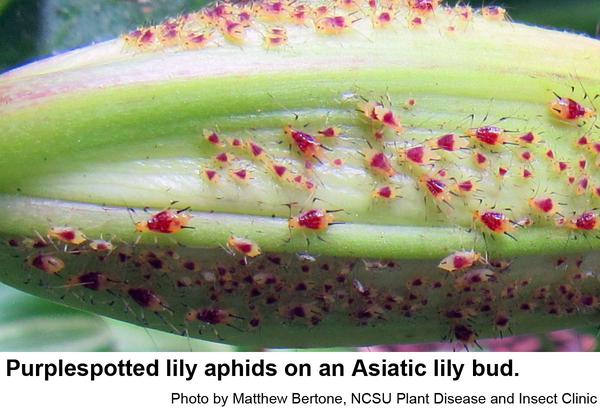Description and Biology
The purplespotted lily aphid, Macrosiphum lilii, is a relatively large, pale yellowish to yellowish-orange aphid with long, black antennae (except the bases); long, black cornicles (structures that resemble dual exhaust pipes on a hotrod); and black "knees" and "feet." The cauda ("tail") is the same pale color of the abdomen. A conspicuous, purple spot occurs on the top of the abdomen. On some specimens, the spot forms a triangle with an apex toward the head. On others, the spot is a blob. Many specimens are wingless, but some develop wings as they develop. Two important aphid pests in the genus Macrosiphum are rose aphids and potato aphids (plus about 80 other species). These aphids all have long legs, antennae, cornicles, and relatively long cauda. I presume the purplespotted lily aphid has a similar life history to the other aphids in this genus. Females give birth to other females during the growing season that develop into wingless and winged adults. In fall, males develop and mate with special females that lay eggs that overwinter to start new generations of all females the following year before males and egg-laying females develop in the fall. Aphids are phloem feeders that extract sap through their slender mouthparts. Sap has a lot of sugars but is weak in other nutrients, so aphids pass along excess sugars as trisaccarides called honeydew. If left untreated accumulating honeydew may support the growth of sooty molds, dark fungi that further disfigure infested plants.
Host Plants
Purplespotted lily aphids have been collected from Asiatic lilies.
Residential Recommendations
In warm weather, parasitic wasps, lady beetles, syrphid fly maggots, lace wings and other predaceous insects may feed on aphids so that aphid populations may decrease rapidly. Aphid populations are sometimes devastated by Cephalosporium lecanii, a fungus that infects aphids as a sort of super athlete's foot disease. Because some ornamental plants are somewhat sensitive to pesticides, lilies should be watered thoroughly before spraying them as wilted plants might be damaged by insecticides. Try to treat them early in the morning or late in the evening so that the pesticide residue is dry before the plants are exposed to direct sunlight. Insecticidal soaps or horticultural oils should give adequate control of aphids although a number of other pesticides are labeled and should also give adequate control. Insecticidal soaps and horticultural oils have less impact on beneficial insects than do Orthene, the pyrethroids and the nicotinoids now widely labeled for home landscape use.
Other Resources
- Aphids and Lillies. McGroarty, K. P. 2019. SFGate, Home Guides, Garden, Pest Control. Hearst.
- Aphids on Ornamental Landscape Plants. Frank, S. 2009. Entomology Insect Notes, NC State Extension Publications.
- Lily, Asiatic lily, Easter lily, Oriental lily—Lilium spp., Family Liliaceae (Lily family). Anonymous. No Date. University of California Agriculture & Natural Resources, UC IPM.
- Horticultural Oils for Ornamental Plants. Frank, S. et al. 2018. Entomology Insect Notes, NC State Extension Publications.
- Extension Plant Pathology Publications and Factsheets
- Horticultural Science Publications
- North Carolina Agricultural Chemicals Manual
For assistance with a specific problem, contact your local Cooperative Extension Center.
This Factsheet has not been peer reviewed.
Publication date: June 15, 2020
Revised: June 15, 2020
Recommendations for the use of agricultural chemicals are included in this publication as a convenience to the reader. The use of brand names and any mention or listing of commercial products or services in this publication does not imply endorsement by NC State University or N.C. A&T State University nor discrimination against similar products or services not mentioned. Individuals who use agricultural chemicals are responsible for ensuring that the intended use complies with current regulations and conforms to the product label. Be sure to obtain current information about usage regulations and examine a current product label before applying any chemical. For assistance, contact your local N.C. Cooperative Extension county center.
N.C. Cooperative Extension prohibits discrimination and harassment regardless of age, color, disability, family and marital status, gender identity, national origin, political beliefs, race, religion, sex (including pregnancy), sexual orientation and veteran status.


